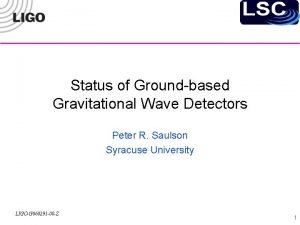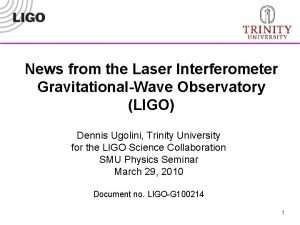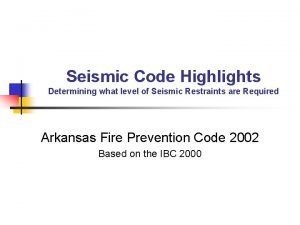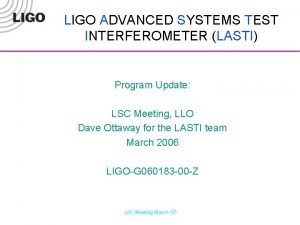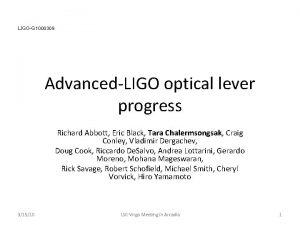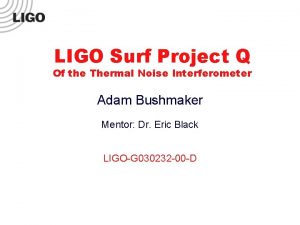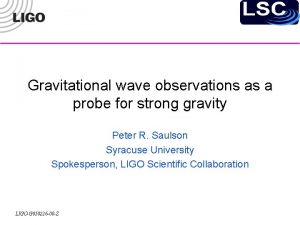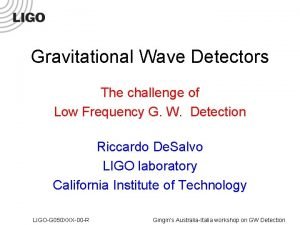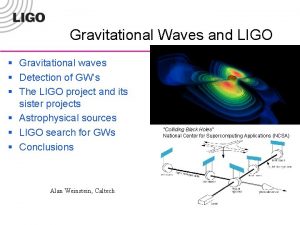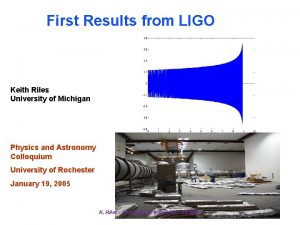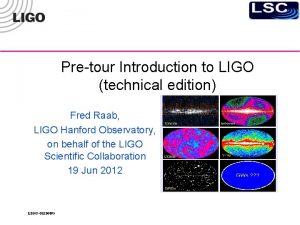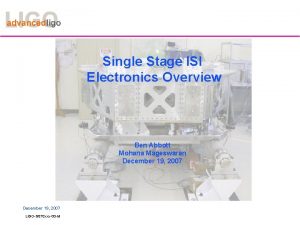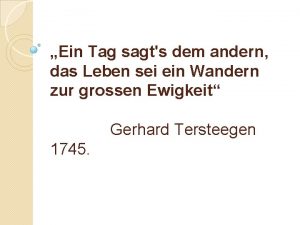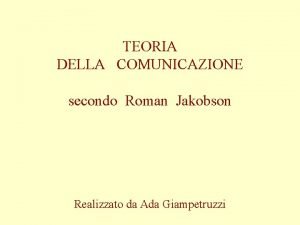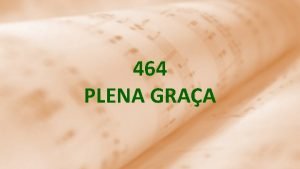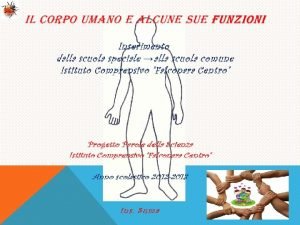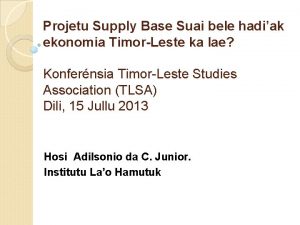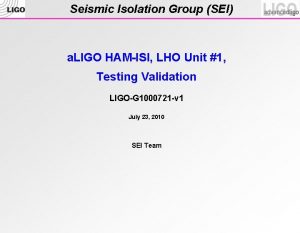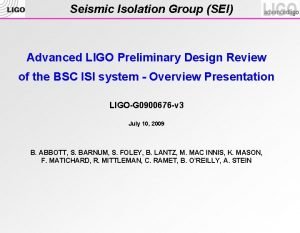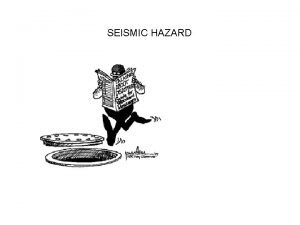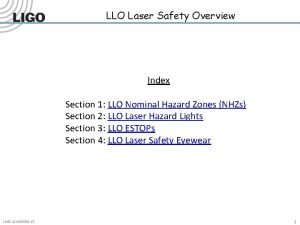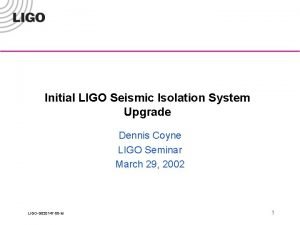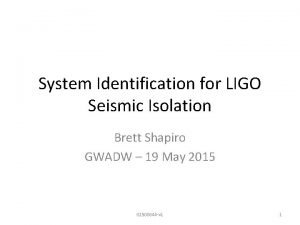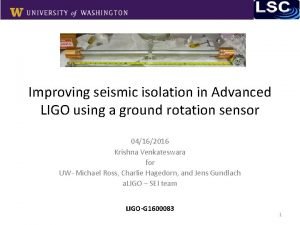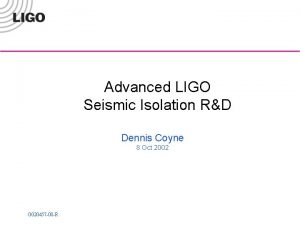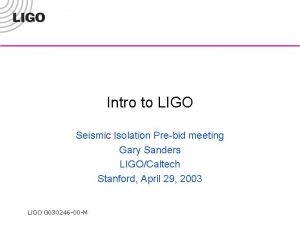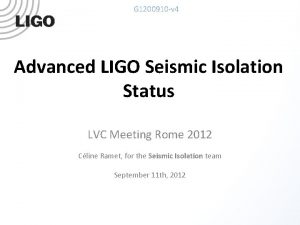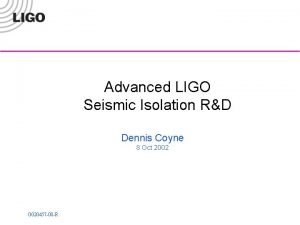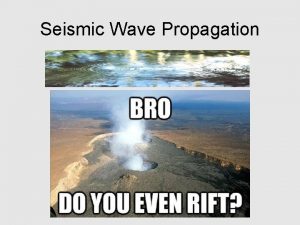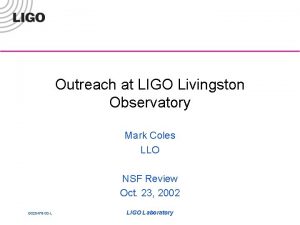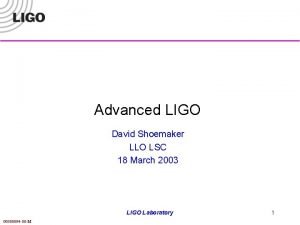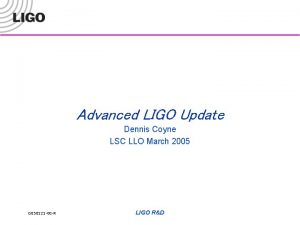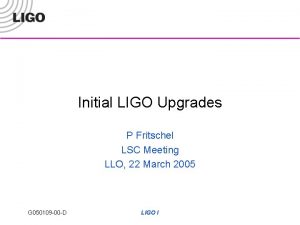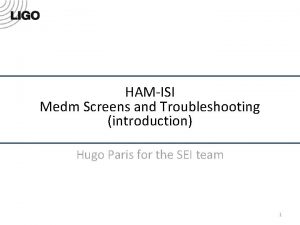Seismic Isolation Group SEI a LIGO HAMISI LLO


































- Slides: 34

Seismic Isolation Group (SEI) a. LIGO HAM-ISI, LLO Unit 3, Testing Validation LIGO-G 1100507 -v 2 April 19 th, 2011 Céline Ramet, Michael Vargas, Adrien Le Roux, Vincent Lhuillier G 1100507 -V 2 1

G 1100507, a. LIGO HAM-ISI, LLO Unit 3, Testing Validation References - E 1000309 - a. LIGO HAM-ISI, Pre-Integration Testing Procedure, Phase I (post assembly, before storage)- Please note that v 5 was used but we’re now using v 6 - E 1000300 - HAM-ISI LLO test stand: software and electronic check - E 1000327 a. LIGO SEI Testing Report, HAM-ISI, LLO - Unit 3 Goals: - Present tests performed on HAM-ISI LLO Unit 3 - Validate HAM-ISI LLO Unit 3 G 1100507 -V 2 2

II. Tests performed during assembly • Step 1 - Check torques on all bolts Passed • Step 2 - Check gaps under Support Posts Passed • Step 3 - Pitchfork/Boxwork flatness before Optical Table install Passed • Step 4 - Blade spring profile Blade # Base (") Tip(") Flatness (mils) 1 . 495 . 491 +4 2 . 501 . 489 +12 3 . 498 . 490 +8 Acceptance Criteria : Blades must be flat within 0. 020" inches Passed Note that all locker shims are identical at 125 mils. G 1100507 -V 2 3

II. Tests performed during assembly • Step 5 - Gap checks on actuators Actuator V 1 V 2 V 3 H 1 H 2 H 3 Front Gap (1/1000") 80 90 95/85 85 80 80 Back Gap (1/1000") 90 75 65/80 Failed Acceptance Criteria : Gaps must be within 0. 010” of design. Can be adjusted before install • Step 6 - Check level of Stage 1 Acceptance Criteria: Maximum tilt of the optical table: 100 μrad Max angle=(. 5/64)/85. 59= 91 urad G 1100507 -V 2 Passed 4

II. Tests performed during assembly • Step 7 - Mass budget and lockers shim thickness Optical Mass (Kg) 305. 00 Wall Mass (Kg) 178. 58 Keel Mass (Kg) 90. 08 Total Mass (Kg) 573. 66 Lockers shim thickness Lockers A B C D Shim thickness (mil) 125 125 Acceptance Criteria : 596. 7 Kg +/-25 Kg (4%) Passed • Step 8 - Lockers adjustment D. I at Lockers A B C D Dial indicators V 0. 5 2 0. 25 -1. 5 Dial indicators H -1 0 0 -1. 5 Acceptance Criteria : Vertical and horizontal displacement near the lockers must be lower than 2 mils G 1100507 -V 2 Passed 5

III. Tests performed after assembly • Step 1 to 3 – Actuators, Sensors and Electronics Inventory Passed • Step 4 - Set up sensors gap Table locked 10 Kg masses at each corners No mass ADE boxes on Sensors H 1 H 2 H 3 V 1 V 2 Offset (Mean) Std deviation -36. 967 1. 2 -109. 44 1. 5 254. 8 1. 1 243. 71 0. 8 -23. 343 0. 7 -91. 761 1. 1 -264. 62 0. 6 -52. 461 1. 6 -148. 73 1. 8 24. 719 1. 5 V 3 196. 35 1. 4 296. 66 1. 2 Acceptance criteria: - All mean values must be lower than 400 cts (a bit less than. 0005”). - All standard deviations below 5 counts. Comments: The two satellite boxes are now synchronized G 1100507 -V 2 6

III. Tests performed after assembly • Step 5 - Measure the Sensor gap Sensors H 1 H 2 H 3 V 1 V 2 V 3 Gap measured on the Jig NR NR NR Gap measured on the table 0. 080" 0. 085" Comments: - Difficult to measure without scratching the target - No information of gaps measured on the Jig Acceptance criteria: - Measured gap must be 0. 080”+/-0. 002” G 1100507 -V 2 Failed 7

III. Tests performed after assembly • Step 6 - Check Sensor gaps after the platform release Sensors H 1 H 2 H 3 V 1 V 2 V 3 Table locked Offset (Mean) Std deviation -274. 44 Table unlocked Offset (Mean) Diff 0. 83234 664. 2 938. 64 -43. 197 0. 75333 -327. 25 -284. 053 159. 76 0. 74358 -561. 14 -720. 9 -296. 64 1. 0669 583. 93 880. 57 245. 48 1. 4453 495. 1 249. 62 -362. 15 1. 627 -1144. 2 -782. 05 Acceptance criteria: - Absolute values of the difference between the unlocked and the locked table must be below 1600 cts (~0. 002”) - Considering the acceptance criteria of step 4, all mean values must be lower than 2000 cts (~0. 0025”) Passed G 1100507 -V 2 8

III. Tests performed after assembly • Step 7 - Check range of motion (hand pushing) • Step 7. 1 – Test Nº 1 Sensors V 1 V 2 V 3 CPS read out UP (Counts) Down (Counts) 20269 -20331 20234 -20363 19885 -19746 Calculated after calibration UP (mil) Down (mil) 24. 0 -24. 1 23. 9 -24. 1 23. 5 -23. 4 Sensors H 1 H 2 H 3 CPS read out CW(-RZ) CCW (+RZ) 18281 -22331 24413 -19937 18099 -22126 Calculated after calibration CW (mil) CCW (mil) 21. 6 -26. 4 28. 9 -23. 6 21. 4 -26. 2 Acceptance criteria: - The vertical sensor readout be positive when the optic table is pushed in the +Z direction - The horizontal sensor readout be negative when the optic table is pushed in the +RZ direction - Absolutes value of all estimated motions must be higher than 16000 counts (~0. 020”) Passed G 1100507 -V 2 9

III. Tests performed after assembly • Step 7 - Check range of motion (hand pushing) • Step 7. 2 – Test Nº 2 H 1 H 2 H 3 V 1 V 2 V 3 Push in positive Push in negative direction 20691 -26431 24701 -24100 25028 -22929 19785 -20422 31629 -32519 19762 -21787 Railing Actuator Gap Check X X X Acceptance criteria: - No contact point on sensors - Absolute value of sensor read out must be higher than 16000 counts (~0. 020”) - No contact point on actuators • Note that we’re not railing on V 2 -different from all other platforms tested so Passed far G 1100507 -V 2 10

III. Tests performed after assembly • Step 8 - Capacitive position sensor Power Spectrum Acceptance criteria: - Magnitudes must lower than Locked at 0. 1 Hz Horizontal CPS 1. E-07 Vertical CPS 4. E-07 Passed Unlocked at 1 Hz 2. E-08 G 1100507 -V 2 5. E-08 at 0. 1 Hz at 1 Hz 5. E-07 8. E-08 8. E-07 4. E-07 11

III. Tests performed after assembly • Step 9 - GS 13 Power Spectrum (Locked and Unlocked configuration) Acceptance criteria: - Magnitudes must be lower than Table locked at 0. 1 Hz H & V Geophones 8. E-05 Horizontal Geophones Vertical Geophones at 0. 1 Hz 3. E-04 5. E-05 at 1 Hz 3. E-08 Taeble unlocked at 1 Hz G 1100507 -V 2 1. E-07 at 10 Hz 2. E-10 at 10 Hz 1. E-11 Passed 12

III. Tests performed after assembly • Step 9 - GS 13 Power Spectrum (Table unlocked with a mass of 20 Kg at each corner of the optic table (1 mass at the time)) Acceptance Criteria: - To be redefined Unlocked (tilted with masses) at 0. 1 Hz H & V Geophones 8. E-05 at 1 Hz G 1100507 -V 2 3. E-08 at 10 Hz 2. E-10 13

III. Tests performed after assembly • Step 10 - Coil Driver, cabling and resistance check Passed • Step 11 - Actuators Sign and range of motion (Local drive) • Step 11. 1 - Actuators sign Acceptance criteria: A positive offset drive on one actuator must give positive sensor readout on the collocated sensor • Passed Step 11. 2 - Range of motion - Local drive H 1 readout (count) H 2 readout (count) H 3 readout (count) V 1 readout (count) V 2 readout (count) V 3 readout (count) Negative drive -24840 -23504 -25079 -19988 -25296 -22424 Positive drive 23704 24473 24232 19535 27191 21599 Acceptance criteria: Main couplings readout must be at least +/-16000 counts (~0. 002”) Passed G 1100507 -V 2 14

III. Tests performed after assembly • Step 12 - Vertical Capacitive Position Sensors Calibration (using dial indicators) Vertical sensitivity: 845. 3 count/mil 0. 63% from nominal value) Acceptance criteria: Deviation from nominal value < 2%. (Nominal is 840 count/mil) • Step 13 – Vertical Spring Constant Passed Vertical spring constant : 2. 50 e 5 N/m (+3. 1% from nominal value) Acceptance criteria: Spring constant is within +/- 10/-1% of 2. 428 e 5 N/m (HPD FEA Results). Actuators (1000 counts) • Step 14 - Static Testing (Tests in the local basis) H 1 H 2 H 3 V 1 V 2 V 3 H 1 1967. 669 1207. 929 1224. 299 201. 7530 -276. 287 159. 632 H 2 1210. 834 2017. 293 1259. 544 172. 320 261. 940 -385. 887 Sensors (counts) H 3 V 1 1224. 792 -3. 392 1256. 419 11. 939 2015. 90 37. 030 -313. 735 1415. 569 230. 952 -554. 369 142. 389 44. 354 Passed V 2 12. 744 21. 785 16. 072 -43. 636 1437. 609 -612. 036 V 3 -33. 92 -21. 05 -30. 849 -546. 33 -44. 960 1403. 71 Acceptance criteria: For a +1000 count offset drive -On Vertical actuators : - Collocated sensors must be 1400 counts +/- 10% -On Horizontal actuators : G 1100507 -V 2 - Collocated sensors must be 2000 counts +/- 10% - Non-collocated horizontal sensors must be 1250 counts +/-10% 15

III. Tests performed after assembly • Step 15 – Linearity test H 1 H 2 H 3 V 1 V 2 V 3 Slope Offset 2. 077 2. 102 2. 075 1. 498 1. 479 1. 484 127. 6 -763 -711 -282 368. 3 -1024 G 1100507 -V 2 Acceptance criteria: Average slope +/3% Average slope 2. 0845 1. 4872 Variation from average (%) -0. 37 0. 83 -0. 46 0. 74 -0. 53 -0. 20 Passed 16

III. Tests performed after assembly • Step 16 - Static tests in the general coordinate basis G 1100507 -V 2 17

III. Tests performed after assembly Sensors readout (count) • Step 16 - Static tests in the general coordinate basis Tests (for a +1000 counts actuation in each Cartesian direction) - Cartesian to local (CONT 2 ACT matrix) - Cartesian to Cartesian (DISP 2 CEN matrix) H 1 H 2 H 3 V 1 V 2 V 3 Direction read out X Drive Y Drive Z Drive Rx Drive Ry Drive Rz Drive 263. 528 232. 73 -492. 32 -5. 871 -21. 28 -390. 4432 510. 05 23. 53 6. 292 -33. 566 39. 232 51. 46 10. 56 248. 899 239. 421 -351. 599 511. 84 70. 06 -510. 236 1633. 514 -234. 314 -214. 09 532. 44 -1619. 426 398. 43 -1870. 593 -1926. 44 -1901. 82 11. 019 -57. 855 2. 8 -18. 2 270. 36 -1169. 8 1208. 911 29. 8 492. 38 524. 71 256. 965 2516. 66 2506. 73 2404. 763 Acceptance criteria : For a positive drive in the Cartesian basis: - Local sensor readout must have the same sign that the reference table (CONT 2 ACT check) - Cartesian sensors read out must be positive (DISP 2 CEN check) in the drive direction Passed G 1100507 -V 2 18

III. Tests performed after assembly • Step 18 – Frequency response – Comparison with HAM 6 • Step 18. 1 – Local to local measurements Horizontal sensors Acceptance criteria: - No major difference with the reference transfer functions (LLO-HAM 6) - Phase – less than 10º - In Phase – Out of Phase Passed - Damping (fit by eye with HAM 6 transfer functions) - DC gain G 1100507 -V 2 19 19 - Eigen frequencies shift less than 5%

III. Tests performed after assembly • Step 18 – Frequency response – Comparison with HAM 6 • Step 18. 1 – Local to local measurements Vertical sensors Acceptance criteria: - No difference with the reference transfer functions (HAM 6 - SVN) - Phase – less than 10º - In Phase – Out of Phase - Damping (fit by eye with HAM 6 transfer functions) G 1100507 -V 2 - DC gain - Eigen frequencies shift less than 5% Passed 20

III. Tests performed after assembly • Step 18 – Frequency response – Comparison with HAM 6 • Step 18. 2 – Cartesian to Cartesian measurements X, Y, RZ direction Acceptance criteria: - No difference with the reference transfer functions (HAM 6 - SVN) - Phase – less than 10º - In Phase – Out of Phase - Damping (fit by eye with HAM 6 transfer functions) G 1100507 -V 2 - DC gain - Eigen frequencies shift less than 5% Passed 21

III. Tests performed after assembly • Step 18 – Frequency response – Comparison with HAM 6 • Step 18. 2 – Cartesian to Cartesian measurements Z, RX, RY direction Acceptance criteria: - No difference with the reference transfer functions (HAM 6 - SVN) - Phase – less than 10º - In Phase – Out of Phase - Damping (fit by eye with HAM 6 transfer functions) G 1100507 -V 2 - DC gain - Eigen frequencies shift less than 5% Passed 22

III. Tests performed after assembly • Step 19 - Lower Zero Moment Plan (TF between 10 m. Hz and 100 m. Hz X Offset: 0. 399 mm Y Offset: 0. 738 mm Acceptance criteria - Both offsets should be inferior to 1 mm G 1100507 -V 2 Passed 23

III. Tests performed after assembly • Step 20 – Damping loops • Step 20. 1 – Transfer functions – Simulations Vertical damping loops – (HAM 6 filters + new electronics compensation) V 1 : solid line V 2 : dash line V 3 : dash-dot line Acceptance criteria: Ham 6 damping loop must implemented and stable with - Phase margin must be at least 45º G 1100507 -V 2 - Gain margin must be at least 20 d. B Passed 24

III. Tests performed after assembly • Step 20 – Damping loops • Step 20. 1 – Transfer functions – Simulations Horizontal damping loops (HAM 6 filters + new electronics compensation) H 1 : solid line H 2 : dash line H 3 : dash-dot line Acceptance criteria: Ham 6 damping loop must implemented and stable with - Phase margin must be at least 45º G 1100507 -V 2 - Gain margin must be at least 20 d. B Passed 25

III. Tests performed after assembly • Step 20 – Damping loops • Step 20. 2 – Powerspectrum – Experimental All damping filters engaged Acceptance criteria: Ham 6 damping loop must implemented and stable G 1100507 -V 2 Passed 26

III. Tests performed after assembly • Step 20 – Damping loops • Step 20. 2 – Suppression – Experimental vs simulation vs HAM 6 simulation All damping filters engaged Blue : Measurement Red : Simulation Green : HAM 6 Acceptance criteria: G 1100507 -V 2 Ham 6 damping loop must implemented and stable 27

IV. Summary • Missing information • Some assembly measurements were done but not recorded at the time • Actuator gaps • Tests results • Passed without major difficulties • Failed tests • Actuator gaps (1 measurement slightly over) • Sensor gaps G 1100507 -V 2 28

Questions?

Back Up Slides

III. Tests performed after assembly • Step 17 – Frequency response • Step 17. 1 – Local to local measurements Horizontal sensors Acceptance criteria: - On CPS, the phase must be 0º at DC - On Geophones, the phase must be -90º at DC G 1100507 -V 2 Passed 31

III. Tests performed after assembly • Step 17 – Frequency response • Step 17. 1 – Local to local measurements Vertical sensors Acceptance criteria: - On CPS, the phase must be 0º at DC - On Geophones, the phase must be -90º at DC G 1100507 -V 2 Passed 32

III. Tests performed after assembly • Step 17 – Frequency response • Step 17. 2 – Cartesian to Cartesian measurements X, Y, RZ direction Acceptance criteria: - On CPS, the phase must be 0º at DC - On Geophones, the phase must be -90º at DC G 1100507 -V 2 Passed 33

III. Tests performed after assembly • Step 17 – Frequency response • Step 17. 2 – Cartesian to Cartesian measurements Z, RX, RY direction Acceptance criteria: - On CPS, the phase must be 0º at DC - On Geophones, the phase must be -90º at DC G 1100507 -V 2 Passed 34
 Biografia del santo hermano miguel
Biografia del santo hermano miguel 9 letras lectoescritura
9 letras lectoescritura Seismic isolation
Seismic isolation Seismic isolation
Seismic isolation Seismic design categories
Seismic design categories Ligo
Ligo Richard abbott ligo
Richard abbott ligo Ligo science education center
Ligo science education center My project q
My project q Ligo
Ligo Ligo challenge xxx
Ligo challenge xxx David shoemaker ligo
David shoemaker ligo Ligo
Ligo Hanford
Hanford Ligo
Ligo Isi electronics
Isi electronics Ligo science education center
Ligo science education center Não sei se a vida é curta
Não sei se a vida é curta Imperativo e indicativo
Imperativo e indicativo L'elefante e i sei saggi ciechi
L'elefante e i sei saggi ciechi Ti sei svegliato
Ti sei svegliato Ein tag der sagts dem anderen
Ein tag der sagts dem anderen Vou te contar uma história de uma jovem chamada maria
Vou te contar uma história de uma jovem chamada maria Giorgio vasari sei poeti toscani
Giorgio vasari sei poeti toscani Quem vai apagar o selo que há em mim
Quem vai apagar o selo que há em mim Senhor eu sei que tu me sondas salmo
Senhor eu sei que tu me sondas salmo E a vida e a vida o que é diga lá meu irmão
E a vida e a vida o que é diga lá meu irmão La parabola della matita testo
La parabola della matita testo Jacobson funzioni
Jacobson funzioni Sei view model
Sei view model Eu sei que eu era culpado
Eu sei que eu era culpado Kira loshin
Kira loshin Ho tanta fede in te montale raccolta
Ho tanta fede in te montale raccolta Omino da costruire con fermacampioni
Omino da costruire con fermacampioni Sei suai
Sei suai


